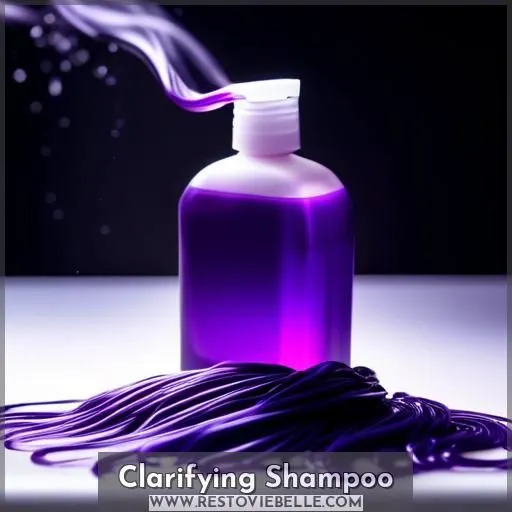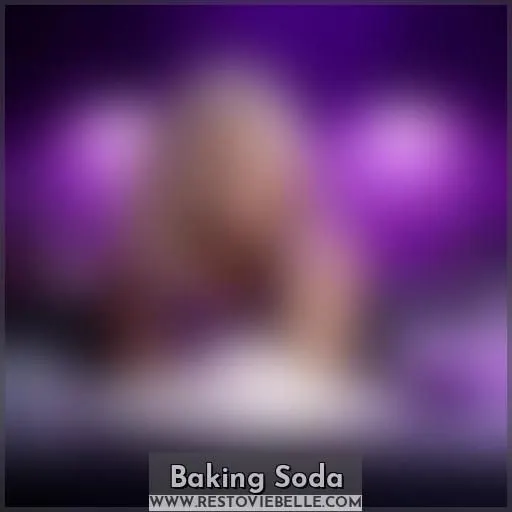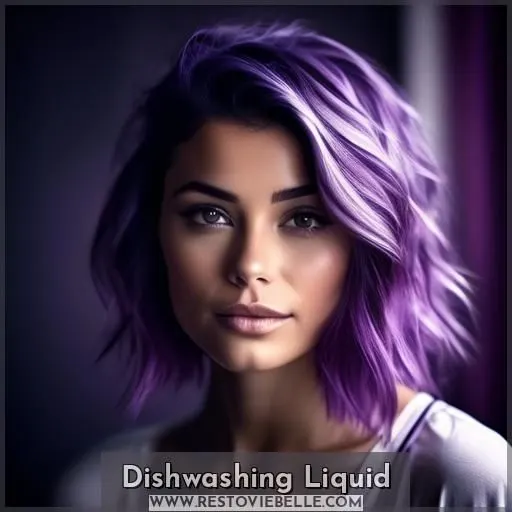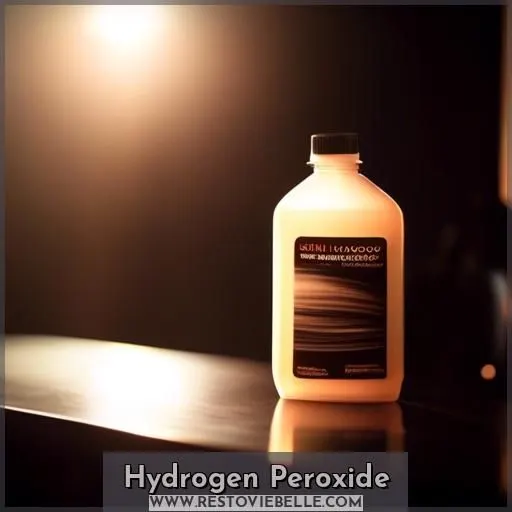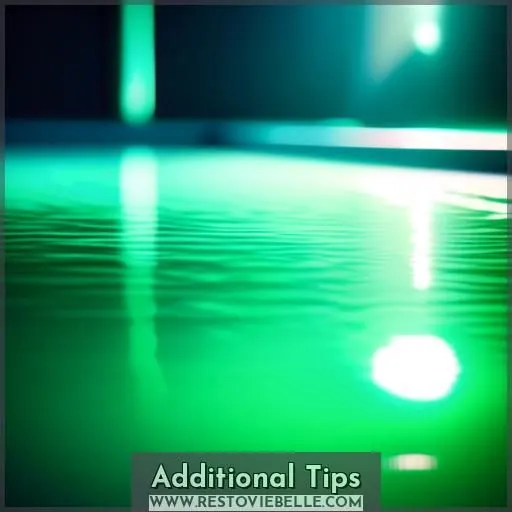This site is supported by our readers. We may earn a commission, at no cost to you, if you purchase through links.
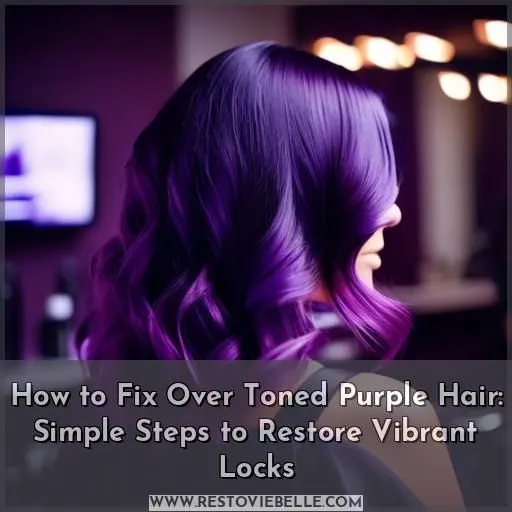 If your hair is looking too purple and dull, don’t worry – there are simple steps to restore vibrant locks. Start by using a clarifying shampoo to remove excess toner. Baking soda or dishwashing liquid can also help lift the color.
If your hair is looking too purple and dull, don’t worry – there are simple steps to restore vibrant locks. Start by using a clarifying shampoo to remove excess toner. Baking soda or dishwashing liquid can also help lift the color.
For a deeper treatment, apply diluted hydrogen peroxide, but don’t leave it on too long. Remember to use purple and blue shampoos/conditioners in moderation to balance out the tone.
By following these tips, you’ll have your hair looking fresh and vibrant in no time.
Table Of Contents
- Key Takeaways
- How to Fix Over Toned Purple Hair?
- Clarifying Shampoo
- Baking Soda
- Dishwashing Liquid
- Hydrogen Peroxide
- Additional Tips
- Frequently Asked Questions (FAQs)
- How long should I leave the baking soda paste in my hair?
- Can I use lemon juice to remove purple shampoo residue?
- Is it safe to use tomato sauce to remove unwanted toner?
- How often should I use clarifying shampoo to remove toner?
- Can I use a clarifying shampoo instead of a color remover to fix over-toned hair?
- Conclusion
Key Takeaways
- Use a clarifying shampoo to remove excess toner and restore natural vibrancy.
- Avoid washing hair solely with dish soap, as it can be too harsh and cause damage.
- Apply diluted hydrogen peroxide for a deeper treatment, but don’t leave it on too long.
- Use purple and blue shampoos/conditioners in moderation to balance out the tone.
How to Fix Over Toned Purple Hair?
To fix over-toned purple hair, start by washing your hair with a clarifying shampoo multiple times to remove the excess toner. This process isn’t the most effective but is the least damaging to your hair.
If the purple residue is light, a clarifying shampoo may suffice. Apply the shampoo to your hair, lather it up, and rinse it out. Repeat this 2-3 times to help remove the tint.
If the purple tint is severe, consider skipping clarifying shampoo and using a commercial color remover or bleach wash. Always follow the instructions when using toners and bleach products to avoid damaging your hair.
Clarifying Shampoo
You can use a clarifying shampoo on dry hair to strip away excess toner and restore your hair’s natural vibrancy. However, avoid washing your hair solely with dish soap, as this can be too harsh and cause further damage.
Clarifying Shampoo Can Be Used on Dry Hair
Venturing into the realm of overtoned hair, you’ve unearthed your secret ally: clarifying shampoo.
Unlike the disastrous dish soap experiment of yore, this savior performs miracles on dry hair, effortlessly purging that persistent purple toner.
After employing its prowess, coddle your strands with an intensive conditioning treatment.
It’s akin to hitting the reset switch, deftly eliminating toner from hair with ease.
Do Not Wash Your Hair With Just Dish Soap
Don’t wash your hair with just dish soap, thinking it’s a clarifying shampoo. Dish soap can strip your hair too much, leading to damage.
Instead, use clarifying shampoo, baking soda, or diluted hydrogen peroxide.
For extensions, avoid using baking soda or hydrogen peroxide.
To fix over-toned purple hair, follow these tips:
Use a clarifying shampoo.
Mix baking soda with shampoo.
Dilute hydrogen peroxide.
Baking Soda
Baking soda is a versatile ingredient that can be used for various purposes, including hair lightening and stripping. Here are three ways to incorporate baking soda into your hair care routine:
- Hair lightening: Baking soda can lighten hair by stripping away color. You can create a paste by mixing baking soda with water and apply it to clean, dry hair. Let it sit for an hour before rinsing it off and following up with a shampoo and conditioner.
- Color correction: Baking soda can be used to correct color mishaps. For instance, if you have over-toned purple hair, you can use baking soda mixed with hydrogen peroxide to lighten the hair and neutralize the purple tones.
- Toner removal: If you want to remove a toner that has caused over-toning, you can mix baking soda with lemon juice to create a paste. Apply this paste to freshly washed damp hair and leave it for 30 minutes before rinsing it off and washing your hair with an anti-dandruff shampoo.
Remember to use baking soda in moderation, as it can be harsh on hair and may cause irritation or dryness. Always follow up with a moisturizing conditioner to prevent damage.
Dishwashing Liquid
Dishwashing liquid can be a clarifying shampoo alternative for those with extreme buildup on the scalp or strands that regular shampoo can’t get rid of. However, it should be diluted and used sparingly, as it can be too harsh for daily use and may cause dryness, brittleness, and breakage.
Additionally, it can strip natural hair oils, which can be particularly concerning for those with damaged, color-treated, and curly or coily hair.
Hydrogen Peroxide
Hydrogen peroxide is a common ingredient in hair dyes and lightening products. It works by breaking down the natural pigments in your hair and lightening its color. However, it can also cause damage to the hair cuticle, which protects and strengthens your strands. This damage can lead to reduced protection, making your hair more vulnerable to breakage and potentially causing hair loss. To minimize damage when using hydrogen peroxide, consider these tips:
- Dilution ratios: Always dilute hydrogen peroxide with water before applying it to your hair. This can help reduce the concentration of the oxidizing agent and minimize damage to your hair.
- Application time: Don’t leave hydrogen peroxide on your hair for too long. Follow the manufacturer’s instructions for the recommended application time to avoid over-processing and damage.
- Porosity considerations: If you have highly porous hair, consider using a lower concentration of hydrogen peroxide or diluting it further to prevent excessive damage.
- Alternative oxidizers: If you’re concerned about the potential damage from hydrogen peroxide, consider using alternative oxidizing agents, such as ammonia-based dyes, which may cause less damage to the hair cuticle.
Additional Tips
You should use purple shampoos and conditioners in moderation to avoid over-toning your hair. Consider using a blue shampoo or conditioner if you notice orange undertones creeping back into your hair.
Use Purple Shampoos and Conditioners in Moderation
To maintain the vibrancy of your locks, use purple shampoos and conditioners in moderation. Overuse can lead to toner build-up, which may cause hair damage and color correction issues.
Follow the product instructions carefully, rinse your hair thoroughly after use, and consider adding a little bit of purple shampoo to your regular shampoo to avoid overuse.
Use Blue Shampoo/conditioner to Correct Orange Undertones
If you’ve got orange undertones in your hair, don’t panic! Blue shampoo is your savior. Here are three ways to correct those orange undertones and bring back your vibrant locks:
- Use Blue Shampoo: Blue shampoo is specifically designed to neutralize orange undertones. It’s like a magic wand for your hair.
- Follow Directions: Always read and follow the product instructions exactly. Trust us, your hair will thank you.
- Color Correction: Ivy St Eve, a hair model and colorist, suggests mixing anti-dandruff shampoo with baking soda for an effective color correction. It’s a game-changer!
Frequently Asked Questions (FAQs)
How long should I leave the baking soda paste in my hair?
Sprinkle some baking soda magic on those locks, partner! Let that paste work its brightening wizardry for 5-10 minutes, then rinse it out squeaky clean. Voila – goodbye, purple haze!
Can I use lemon juice to remove purple shampoo residue?
Absolutely, lemon juice is a gentle yet effective way to help remove stubborn purple shampoo residue. Just apply it, let it sit for a few minutes, then rinse thoroughly. Voilà – fresher, cleaner hair!
Is it safe to use tomato sauce to remove unwanted toner?
Woah there, friend! I wouldn’t recommend slathering tomato sauce on your hair – that’s a recipe for a saucy disaster! Stick to the trusty methods we discussed earlier. Your locks will thank you, I promise.
How often should I use clarifying shampoo to remove toner?
Toner troubles got you feeling like a purple people eater? Use clarifying shampoo 2-3 times a week to banish that unwanted hue – any more and you risk drying out your locks. Trust me, your hair will thank you!
Can I use a clarifying shampoo instead of a color remover to fix over-toned hair?
Yes, you can use a clarifying shampoo to fix over-toned hair instead of a color remover. Just be sure to follow up with a deep conditioning treatment to hydrate your strands. It’s an easy fix!
Conclusion
Ultimately, taming your overtoned purple hair is a breeze. By using a clarifying shampoo, baking soda, or even a dash of dishwashing liquid, you can easily lift that unwanted color and restore your vibrant locks.
Don’t forget, a touch of hydrogen peroxide can also do the trick, just be sure not to overdo it.
With these simple steps, you’ll have your hair looking fresh and fabulous in no time. So, bid farewell to that dull, overtoned purple hair and welcome back the vibrant you!
